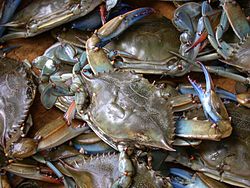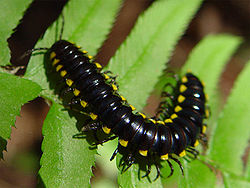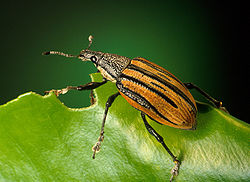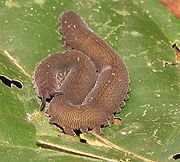
Arthropod
Background Information
This wikipedia selection has been chosen by volunteers helping SOS Children from Wikipedia for this Wikipedia Selection for schools. With SOS Children you can choose to sponsor children in over a hundred countries
| Arthropods Temporal range: Cambrian or earlier – Recent |
|
|---|---|
 |
|
| Tarantula Brachypelma sp. | |
| Scientific classification | |
| Kingdom: | Animalia |
| Phylum: | Arthropoda Latreille, 1829 |
| Subphyla and Classes | |
|
|
Arthropods are animals belonging to the Phylum Arthropoda (from Greek ἄρθρον arthron, " joint", and ποδός podos" foot", which together mean "jointed feet") and include the insects, arachnids, crustaceans and allies. Arthropods are characterized by the possession of a segmented body with appendages on at least one segment. They have a dorsal heart and a ventral nervous system. All arthropods are covered by a hard exoskeleton made of chitin, a polysaccharide, which provides physical protection and resistance to desiccation. Arthropods grow by shedding this covering in what are termed molts.
They are the largest phylum in the Animal Kingdom with more than a million described species making up more than 80% of all described living species, and a fossil record reaching back to the late proterozoic era. Arthropods are common throughout marine, freshwater, terrestrial, and even aerial environments, as well as including various symbiotic and parasitic forms. They range in size from microscopic plankton (~¼ mm) up to forms several metres long. The largest living arthropod is the Japanese spider crab, with a leg span up to 3½ m (12 ft), and some prehistoric arthropods were even larger, such as Jaekelopterus and Arthropleura.
Basic arthropod structure
The success of arthropods is related to their hard exoskeleton, segmentation, and jointed appendages. The appendages are used for feeding, sensory reception, defense, and locomotion. The muscle system is more or less assisted by hydraulics originated from the blood pressure, created by the hearts of the animals. The hydraulic system in spiders is especially well developed.
Aquatic arthropods use gills to exchange gases. These gills have an extensive surface area in contact with the surrounding water. Terrestrial arthropods have internal surfaces that are specialised for gas exchange. Insects and most other terrestrial species have tracheal systems: air sacs leading into the body from pores called spiracles in the epidermis cuticle. Others use book lungs, or gills modified for breathing air as seen in species like the coconut crab. Some areas of the legs of soldier crabs are covered with an oxygen absorbing membrane. The gill chambers in terrestrial crabs sometimes have two different structures: one that is gilled and used for breathing underwater, and another specially adapted to take up oxygen from the air (a pseudolung). Arthropods also have a complete digestive system with both a mouth and anus.
Arthropods have an open circulatory system. Haemolymph containing haemocyanin, a copper-based oxygen-carrying protein (the copper makes the blood blue, unlike humans, which use hemoglobin, which uses iron, which makes it red). The blood is propelled by a series of hearts into the body cavity where it comes in direct contact with the tissues. Arthropods are protostomes. There is a coelom, but it is reduced to a tiny cavity around the reproductive and excretory organs, and the dominant body cavity is a haemocoel, filled with haemolymph, which bathes the organs directly. The arthropod body is divided into a series of distinct segments, plus a pre-segmental acron, which usually supports compound and simple eyes and a post-segmental telson. These are grouped into distinct, specialised body regions called tagmata. Each segment, at least primitively, supports a pair of appendages.
The cuticle in arthropods forms a rigid exoskeleton, composed mainly of chitin, which is periodically shed as the animal grows. They contain an inner zone ( procuticle), which is made of protein and chitin and is responsible for the strength of the exoskeleton. The outer zone ( epicuticle) lies on the surface of the procuticle. It is nonchitinous and is a complex of proteins and lipids. It provides the moisture proofing and protection to the procuticle. The exoskeleton takes the form of plates called sclerites on the segments, plus rings on the appendages that divide them into segments separated by joints. This is in fact what gives arthropods their name — jointed feet — and separates them from their relatives, the Onychophora and Tardigrada, also called Lobopoda (and which is sometimes included in a group called Panarthropoda that also includes arthropods). The exoskeletons of arthropods strengthen them against attack by predators and are impermeable to water. In order to grow, an arthropod must shed its old exoskeleton and secrete a new one. This process, ecdysis, is expensive in terms of energy, and during the molting period, an arthropod is vulnerable.
Classification of arthropods
|
Arthropods are typically classified into five subphyla, of which one is extinct:
- Trilobites are a group of formerly numerous marine animals that died in the mass extinction at the end of the Permian-Triassic extinction event.
- Chelicerates include spiders, mites, scorpions and related organisms. They are characterised by the presence of chelicerae.
- Myriapods comprise millipedes and centipedes and their relatives and have many body segments, each bearing one or two pairs of legs. They are sometimes grouped with the hexapods.
- Hexapods comprise insects and three small orders of insect-like animals with six thoracic legs. They are sometimes grouped with the myriapods, in a group called Uniramia, though genetic evidence tends to support a closer relationship between hexapods and crustaceans.
- Crustaceans are primarily aquatic (a notable exception being woodlice) and are characterised by having biramous appendages. They include lobsters, crabs, barnacles, crayfish, shrimp and many others.
Aside from these major groups, there are also a number of fossil forms — mostly from the lower Cambrian — including anomalocarids, euthycarcinoids and Arthrogyrinus, which are difficult to place, either from lack of obvious affinity to any of the main groups or from clear affinity to several of them.
The phylogeny of the arthropods has been an area of considerable interest and dispute. The validity of many of the arthropod groups suggested by earlier authors is being questioned by recent studies; these include Mandibulata, Uniramia and Atelocerata. The most recent studies tend to suggest a paraphyletic Crustacea with different hexapod groups nested within it. The remaining clade of Myriapoda and Chelicerata is referred to as Paradoxopoda or Myriochelata.
Since the International Code of Zoological Nomenclature recognises no priority above the rank of family, many of the higher groups can be referred to by a variety of different names.
Evolution
|
Arthropods are today almost universally considered to be monophyletic, i.e. they only arose once, a view supported by both morphological and molecular studies. Such a view contradicts the widespread view in the 1970s that the arthropods had evolved on several occasions from soft-bodied, annelid-like ancestors.
The closest relatives of the arthropods are usually considered to be the Tardigrada and Onychophora, together forming the monophyletic group Panarthropoda (the crustaceans, myriapods, chelicerates and insects are often referred to as "Euarthropoda" to distinguish them from their soft-bodied relatives). Comparison between these groups suggests that the euarthropods evolved from a soft-bodied ancestor not too dissimilar to the living onychophorans, a view that has found some support from the fossil record.
Traditionally the Annelida have been considered the closest relatives of these three phyla, on account of their common segmentation. Molecular data however, is strongly against this grouping (known as the Articulata), suggesting instead that the panarthropods belong in a clade including both the arthropods and various pseudocoelomates such as roundworms and priapulids that share with them growth by moulting, or ecdysis, from which its name, the Ecdysozoa. is derived. If this new grouping is correct, then segmentation of arthropods and annelids has either evolved through convergence, or has been inherited from a very deep ancestor, and has been subsequently lost in several other lineages, such as the non-arthropod members of the Ecdysozoa.





